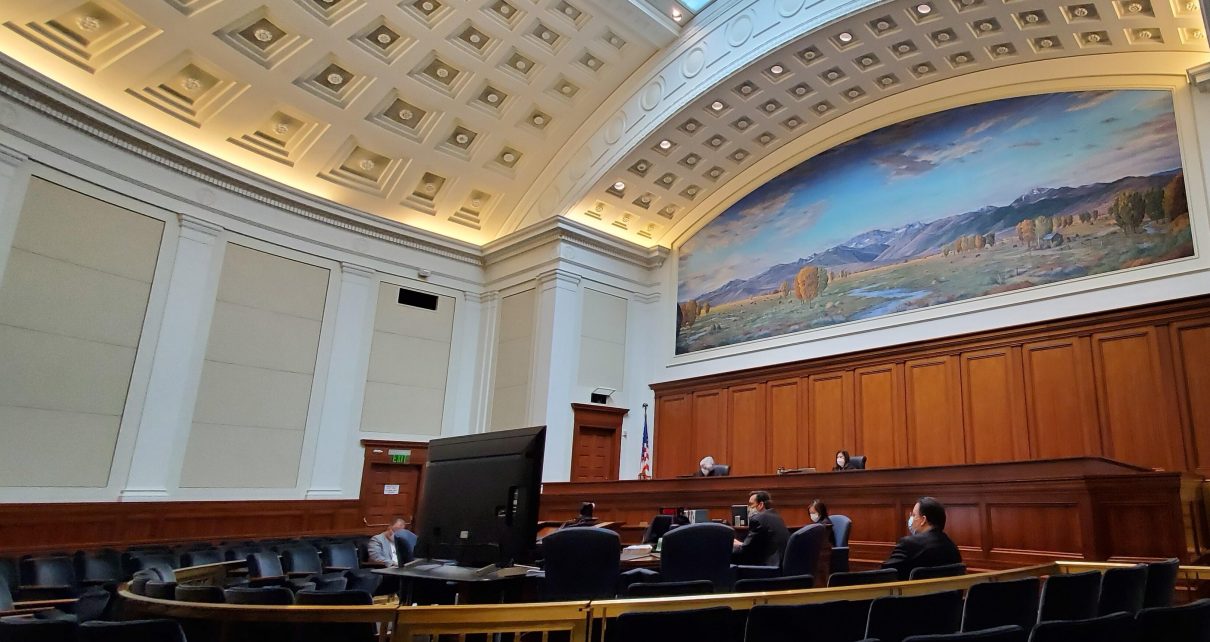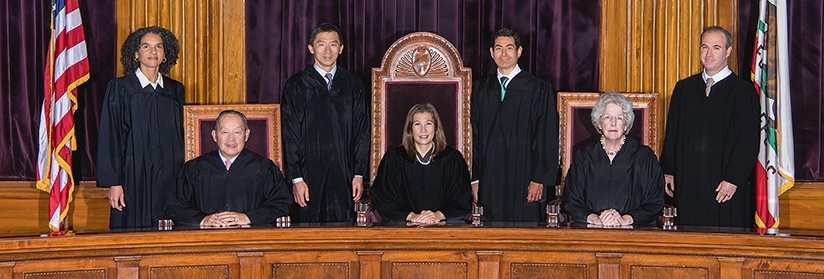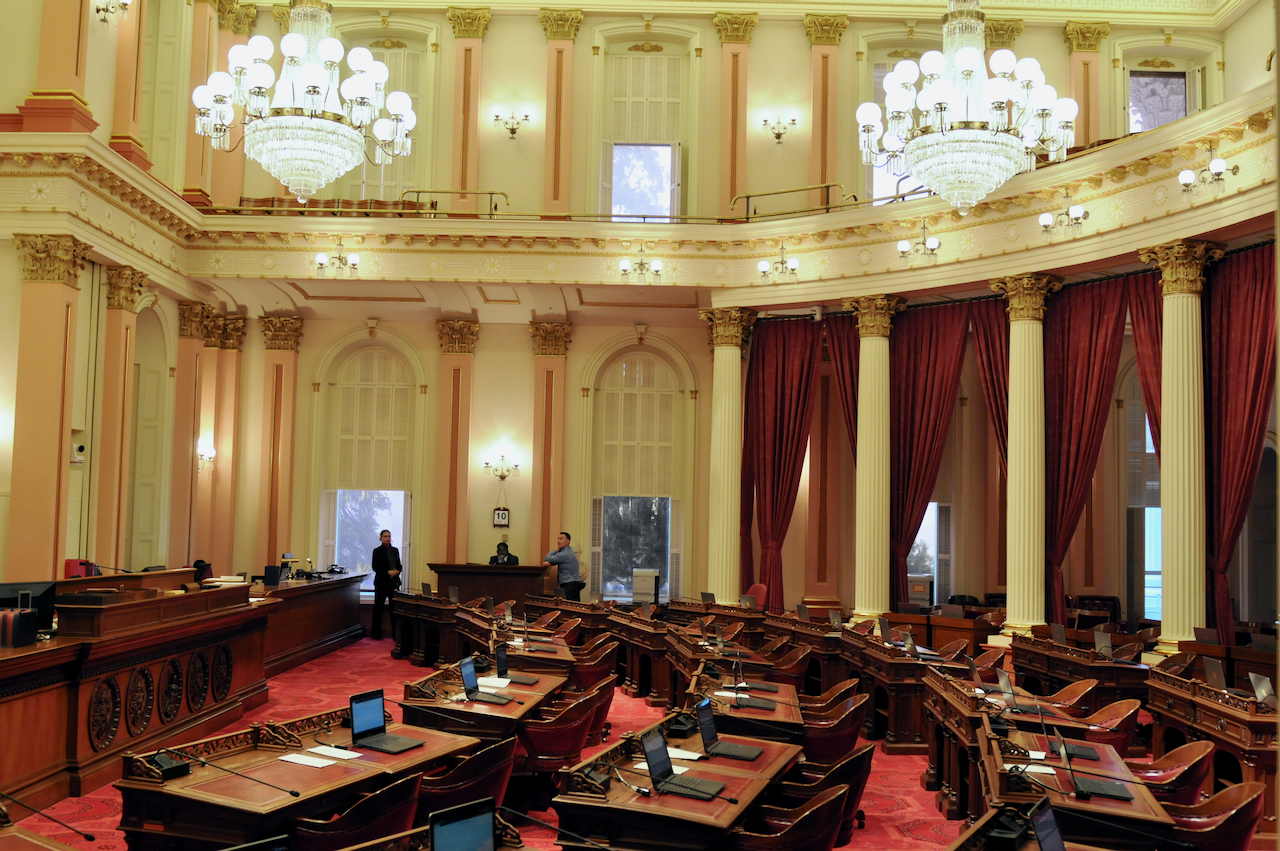
California Supreme Court. (Photo: newsroom.courts.ca.gov)
California Supreme Court’s Most Recent Statutory Interpretation Case
The Court’s decision sets forth important statutory construction principles, as well as the use of legislative history
By Chris Micheli, November 6, 2024 4:36 pm
On October 28, 2024, the California Supreme Court unanimously decided North American Title Company, et al. v. Superior Court of Fresno County (Cortina, et al., Real Parties in Interest). The high court’s 7-0 decision was written by Chief Justice Guerrero and it provides the most recent example of a statutory interpretation case decided by the justices.
The Court’s decision sets forth important statutory construction principles, as well as the use of legislative history, governing the courts in this state and providing important guidance to legislators, staff, advocates, and attorneys working in and around the California State Capitol who deal with bills and proposed statutory language.
In reviewing the statutory scheme to understand the two parties’ differing perspectives, the Supreme Court explained, “The Legislature quite reasonably could have enacted statutory language that treats judicial self-disqualification differently from party-initiated disqualification attempts. Judicial self-disqualification involves an admission of bias or prejudice, which the Legislature could reasonably decide was not waivable by the parties. A party-initiated disqualification attempt, by contrast, involves only an allegation of bias or prejudice. It does not necessarily mean the judge is actually biased or prejudiced. The Legislature could reasonably have placed a timeliness requirement on such party-initiated statements of judicial qualification to encourage parties to bring possible conflicts to the court’s attention promptly and avoid potential gamesmanship and delay. On the other hand, the Legislature may have been less concerned about the timeliness of judicial self-disqualification because such disqualification is compelled by a judicial officer’s ethical duties and does not pose the same risk of, or incentive for, misuse of the disqualification process. Determining the scope of section 170.3(c)(1)’s timeliness requirement presents “a question of statutory construction, which we review de novo.” (Turner v. Victoria (2023) 15 Cal.5th 99, 111.)”
While the Court’s reasoning includes speculation of what the Legislature may have been concerned with, the justices also made clear that the Legislature is charged with drafting the laws and, therefore, can add or omit certain provisions of statutes. The Court also explained how it engages in statutory interpretation:
“‘“‘When we interpret a statute, “[o]ur fundamental task . . . is to determine the Legislature’s intent so as to effectuate the law’s purpose. We first examine the statutory language, giving it a plain and commonsense meaning. We do not examine that language in isolation, but in the context of the statutory framework as a whole in order to determine its scope and purpose and to harmonize the various parts of the enactment. . ..” . . . “Furthermore, we consider portions of a statute in the context of the entire statute and the statutory scheme of which it is a part, giving significance to every word, phrase, sentence, and part of an act in pursuance of the legislative purpose.”’”’” (Los Angeles Unified School Dist. v. Superior Court (2023) 14 Cal.5th 758, 767–768 (Los Angeles Unified).)”
California courts first look to the language as enacted by the Legislature. If the language, given its plain meaning, is clear, then the inquiry ends and the courts apply the plain language of the statute. As the high court noted, they review the particular language at issue in the case in the broader context of the over statutory scheme in which that language is found. And, because the Legislature is presumed to draft each statute and choose its words carefully, the courts give significance to the words of the statute.
The Court in this case then explained, “Under its plain terms, then, section 170.3(c)(1)’s timeliness requirement does not exclude instances in which it is alleged as a ground of disqualification that a judge “has a personal bias or prejudice concerning a party” (§ 170.3, subd. (b)(2)(A)) or “served as an attorney in the matter in controversy, or . . . has been a material witness concerning that matter” (§ 170.3, subd. (b)(2)(B)). Similarly, the Legislature did not create any exceptions in specifying that a challenged judge may strike an untimely statement of disqualification (§ 170.4, subd. (b)). We agree that the text and structure of section 170.3, subdivision (b) are especially insightful to the question before us. However, they do not support the Court of Appeal’s interpretation that section 170.3(b)(2)’s nonwaiver provision extends beyond the written waiver process specified in section 170.3, subdivision (b)(1).
The Supreme Court went on to say, “‘It is elementary that, absent indications to the contrary, “a word or phrase . . . accorded a particular meaning in one part or portion of the law, should be accorded the same meaning in other parts or portions of the law . . ..” [Citation.]’” (Curle, supra, 24 Cal.4th at p. 1067; see also City of Los Angeles v. County of Los Angeles (1989) 216 Cal.App.3d 916, 924 [“Where the same term or phrase is used in a similar manner in two related statutes concerning the same subject, the same meaning should be attributed to the term in both statutes unless countervailing indications require otherwise”].)
These statements explain why consistency in legislative drafting is so critical. The same term should mean the same thing throughout a statutory scheme. And, when the same term is used in two similar statutes, then the same meaning to that word will be used by the courts.
The high court then applied the principle, “Here, section 170.3, subdivision (b)(1) and section 170.3(b)(2) concern “the same subject.” (City of Los Angeles, at p. 924; see also People v. Partee (2020) 8 Cal.5th 860, 868.) They were enacted at the same time, within the same legislative measure. (See Stats. 1990, ch. 910, § 1, p. 3858 [enacting Sen. Bill No. 2316 (1989–
1990 Reg. Sess.)]; see also Partee, at p. 868 [noting that the two relevant provisions were enacted in the same year “in the same title”].) And they were placed immediately next to each other in the code. Thus, contrary to the Court of Appeal’s assertion, the language of section 170.3(b)(2), read in context with section 170.3, subdivision (b)(1), indicates that the Legislature intended the phrase “‘waiver of disqualification’” in section 170.3(b)(2) to refer to “express waiver” (North American Title, supra, 91 Cal.App.5th at p. 981) — or more precisely, the express written waiver referenced in the previous subdivision.”
The high court went on to explain how it compared and contrasted the statutory language to confirm its interpretation: “The absence of any such limitation in either of those statutes is particularly striking when compared to the carve-out language that limits the application of section 170.3, subdivision (b)(1). If the Legislature had intended to excuse the timeliness requirement when the basis for disqualification falls within the categories described in subdivision (b)(2), we may expect that it would have expressly stated as much, just as it did in subdivision (b)(1). In addition, the statutory structure supports Real Parties in Interest’s argument that the nonwaiver provision in section 170.3(b)(2) is concerned only with the process of judicial self-disqualification. (See, e.g., Valencia, supra, 3 Cal.5th at p. 361 [“the location of the provision in question . . . is informative”]; Hull, supra, 1 Cal.4th at p. 272 [stating that a certain statutory interpretation of the provisions governing judicial disqualification is supported by “[a]n examination of the framework of the disqualification statutes”].) Notably, section 170.3(b)(2) is surrounded by provisions that address circumstances in which a judge has decided that he or she is disqualified.”
The justices also encouraged the proper use of precise language. “We encourage courts and litigants to use precise terminology and avoid terms like “waiver” or “implied waiver” when discussing the potential consequence of failing to take timely action pursuant to statute, including the requirement to present a timely statement of disqualification pursuant to section 170.3(c)(1).”
The high court utilized another common principle of statutory construction, that the Legislature is aware of judicial decisions and takes them into consideration when drafting statutes. “Even assuming the Legislature was aware of Caminetti and similar cases, however, it does not follow that the Legislature intended for the nonwaiver provision of section 170.3(b)(2) to alter the scope of section 170.3(c)(1)’s “earliest practical opportunity” timeliness requirement. Notably, although Caminetti held the failure to pursue disqualification at the earliest practicable opportunity results in waiver, the court also stressed that the “‘earliest practicable opportunity’” requirement affords “an additional statutory means by which a disqualification . . . may be waived” that is distinct from “a written stipulation” indicating the parties have no objection to an otherwise-disqualified judge presiding over the matter. (Caminetti, supra, 22 Cal.2d at p. 391, italics added.) Thus, consistent with Caminetti, the Legislature could have enacted section 170.3(b)(2), prohibiting a “stipulation” waiving certain disqualification bases, yet left unchanged the “additional” statutory requirement of timeliness under section 170.3(c)(1). (Caminetti, at p. 391.)”
The Supreme Court then turned to the legislative history of the particular statute. “The legislative history of sections 170.3(b)(2) and 170.3(c)(1) bolsters the conclusion that the nonwaiver provision applies only to circumstances of judicial self-disqualification. (See, e.g., Larkin v. Workers’ Comp. Appeals Bd. (2015) 62 Cal.4th 152, 164 (Larkin) [consulting legislative history “[t]o the extent any uncertainty nonetheless persists” after examining the statutory text and structure].) Similarly, a legislative committee analysis of Senate Bill No. 2316 stated that the bill “would prohibit a waiver of disqualification in cases where the judge has indicated a need for recusal.” (Sen. Com. on Judiciary, Analysis of Sen. Bill No. 2316 (1989–1990 Reg. Sess.) as introduced Feb. 27, 1990, p. 2, italics added [“This bill would prohibit a waiver of disqualification in cases where the judge has indicated a need for recusal due to personal bias or prejudice against a party to the proceeding, or because of status as a prior attorney or material witness in the matter”]; see also id. at p. 1 [“Key Issue” presented in the legislation is whether “a waiver of judicial disqualification [should] be prohibited to the parties in an action when the judge has disqualified himself or herself on the basis of personal bias or prejudice” (italics added & capitalization omitted)]; Sen. Rules Com., Off. of Sen. Floor Analyses, Analysis of Sen. Bill No. 2316 (1989–1990 Reg. Sess.) as introduced Feb. 27, 1990, pp. 1–2 [similar language].)”
The high court noted that the appellate court had not properly utilized the legislative history. “The Court of Appeal did not discuss the above-mentioned legislative history materials. Instead, it emphasized other language that stated Senate Bill No. 2316 “‘“‘helps assure that even the shadow of bias is kept out of our courts.’”’” (See North American Title, supra, 91 Cal.App.5th at p. 977; see id. at pp. 980, 982, 994.) The Court of Appeal asserted that its construction of the statute “aligns with th[is] purpose” of the bill. (Id. at p. 982.)”
The justices concluded, “In sum, the legislative history supports, and in no way undermines, what we gleaned from the statutory text and structure: the prohibited bases for waiver of disqualification — bias or prejudice, and service as an attorney or witness in the matter — are implicated only where judicial self-disqualification is involved. They are not relevant when “a judge who should disqualify himself or herself refuses or fails to do so” (§ 170.3(c)(1)), and a party therefore seeks to disqualify a judge by filing a written verified statement of disqualification. In this latter situation, the Legislature adopted a statutory procedure which requires a party to file a written statement of verification “at the earliest practicable opportunity” (ibid.) regardless of the asserted basis for disqualification under section 170.1.”
This California Supreme Court decision provides its most recent views on statutory interpretation principles to be used by state courts when construing California statutes. From the plain meaning rule, to the use of legislative history, the high court’s decision contains important reminders when drafting legislation and how to interpret statutory language.
- Effect of Emancipation - December 6, 2025
- Harbor Commissions in California - December 5, 2025
- Mediation Proceedings in Child Custody Cases - December 5, 2025




